Read my amazing true life story about how the forces of good and evil battle for my life and the vision that God has given me. My book, “Possess the Vision,” communicates my supernatural experiences and as a result, provides insight into the realm of the spiritual warfare that is raging for our souls and our purpose. This is a must read for all Christians. Learn more by following this link:Possess-the-Vision-at-Amazon
Entering The Truth Of The Tabernacle
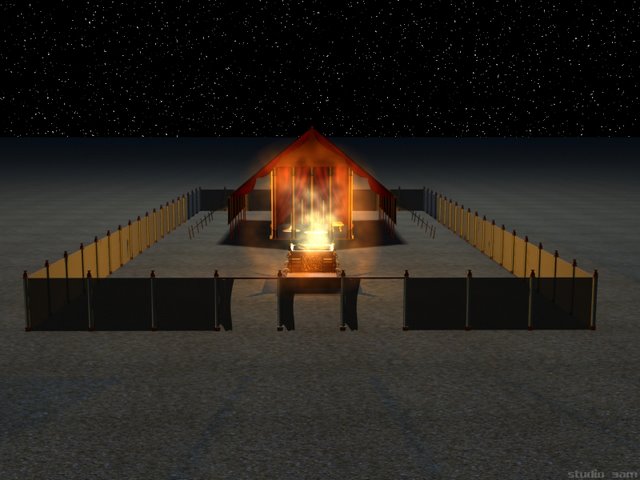
The Tabernacle Courtyard
In our previous postings we have communicated how the Tabernacle Courtyard is prophetic of Jesus Christ. The Courtyard foretells the blood sacrifice required of Jesus as payment for our sins on the cross. It also communicates that we must look at ourselves in light of the prefect model of Jesus. We must compare our actions and words to His since He is the Son of God and led a perfect life. In doing these things we enter into a relationship of grace with God. This fundamental relationship with God prepares us for a closer and more intimate relationship with Him. It prepares us for a relationship of empowerment, which is presented below in the section entitled “Jesus is the Truth.”

Our immediate objective is to present a review of the material that covers the Tabernacle as it pertains to the prophesy of Jesus Christ. We start with one of the most famous statements of Jesus, “I am the Way, the Truth and the Life.”
The Way the Truth and the Life
The foundation for all of the work we will present on this subject is based upon the, “I am the Way, the Truth and the Life,” statement made by Jesus. What we have discovered is that these names, (the way, the truth and the life), are the names used to identify the entry ways into the Tabernacle chambers. “The Way,” for example is the name of the gate that leads into the Tabernacle Courtyard. “The Truth” is the name of the door into the Holy Place, and in like manner, “the Life,” is the passage into the Most Holy place of God. For a more detailed explanation of all of this please follow this link Jesus-is-the-Way-the-Truth-and-the-Life.
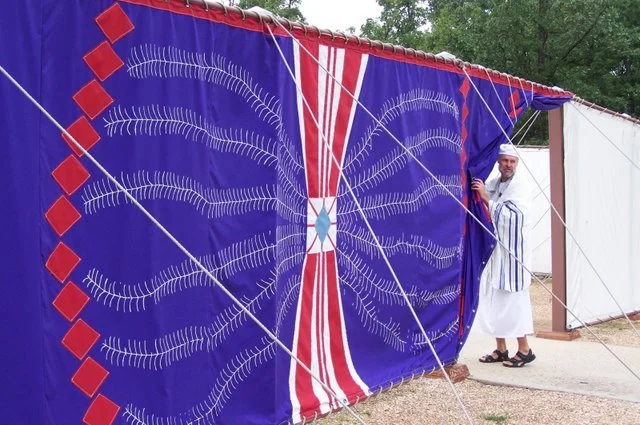
Another part of the work covered to date is that the Tabernacle is the place where God promised to dwell with His people in accordance with the covenant He made with them. Given that the chambers of the Tabernacle must be entered in sequence, what we have uncovered is that a progressively closer relationship with God is achieved as each new chamber is entered. So for example, the Tabernacle Courtyard is the chamber where a relationship of grace (forgiveness of sin) is achieved. The Holy Place brings us to a relationship of enlightenment (purpose and path) and empowerment (spiritual warfare), while the Most Holy place offers a relationship of covenant (dwelling under the protection of God).
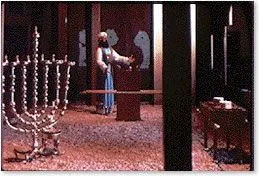
To date our investigation of the Tabernacle has been limited to looking at the Courtyard, the first of the three chambers of the Tabernacle. As a part of this investigation we have presented the objects found in the Courtyard, identified their purpose and attributes and then correlated them to the words and deeds of Jesus. So, for example, we found that grace is achieved in the Courtyard by way of blood sacrifice, in which a Lamb is slaughtered and then burned on the Brazen Alter (see details at Jesus-the-Brazen-Laver.) We can then associate Jesus, the “Lamb of God,” to this object by correlating it to the sacrifice and death of Jesus on the cross. This sacrifice of Jesus was required for the forgiveness of our sins. We conclude form all of this that Jesus is the fulfillment of the Brazen Altars prophesy and the entire Courtyard of the Tabernacle for that matter. This association between Jesus and the Tabernacle Courtyard should also help us to better understand what Jesus meant when He said “I am The Way.” Jesus meant that He is the way toward a relationship of grace. For more information about this please click on the following links to Jesus-is-the-Way and Becoming-like-Jesus-the-Way.
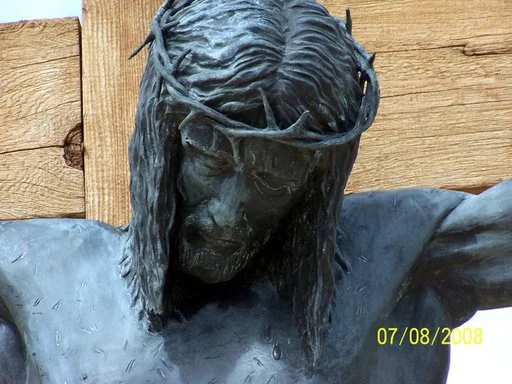
Our investigation of the Courtyard is also presented an examination of the Brazen Laver, which is the other object found in the Tabernacle Courtyard (for more details go to Jesus-the-Brazen-Laver.) The Laver is a water basin used for purification prior to entering the next chamber (the Holy Place), which represented a much closer relationship with God. The process of washing at the Laver required the priest to bend over it and as he did, he would be able to see his own reflection in its polished surface. The priests believed that when they looked into the Laver, that they saw themselves as God saw them. As a result their hidden faults were uncovered and they earnestly contemplated their worthiness to enter into a closer relationship with God in the Holy Place. This reflection resulted in a change in heart, which is necessary to enter into the Holy Place.
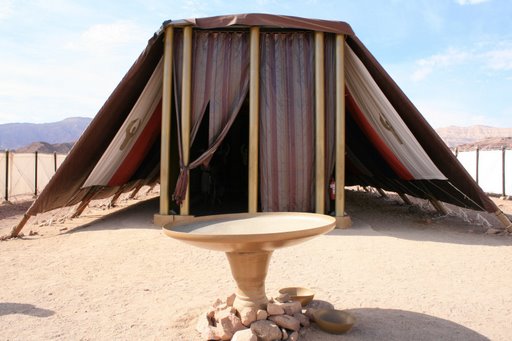
We then connected the function and attributes of the Laver with the life and words of Jesus. We used the baptism of Jesus in the Jordan as a fulfillment of prophesy of the Laver (for more information go to the-Laver-and-the-Holy-Spirit-of-Jesus.) We also saw how the washing of His disciple’s feet became a reflection of their readiness to enter into His ministry. In general we conclude that all of the words and deeds of Jesus are occasions for reflection and opportunities for change in preparation for ministry. Therefore our reading of scriptures that contain the words and deeds of Jesus are opportunities for reflection about our nature and how we stack up to in comparison to Jesus, our model of perfection. These occasions are opportunities to conform our heart and mind to Him as we pursue a more intimate relationship with God. For more detailed information about this click on the following link Applying-the-attributes-of-Jesus-our-Laver.
So, by passing through “the Way” and into the Tabernacle Courtyard we find that our sins are forgiven and that our nature is changed as we seek to move into a deeper relationship with the Lord in the Holy Place. In a like manner we find that by passing through Jesus that our sins are forgiven and our nature is changed as we read His word and seek to become like Him. When this metamorphosis is complete we become ready to move to the next level by entering the passageway called “The Truth.”
The Truth leads us into the Holy Place of God where our pathway with the Lord is enlightened, our relationship with the Father is established and we become empowered for spiritual warfare. We are ready to provide a deeper assessment of, “Jesus the Truth.”
Jesus is “The Truth”
We are now about to pass through the second door of the Tabernacle, the one called “the Truth”, that leads us into the Holy Place of God. To see a diagram of the Tabernacle chambers we encourage you to go to the following web page now and then return once you have viewed it (or open it in a separate browser so that you can read along while also looking at the picture):
Diagram of the Tabernacle, Basic Layout of the Moses tabernacle
In order to get a big picture view of where we are headed in the over all scheme of things we start with a review:
When we look into the structure of the Tabernacle (like in the diagram above) we find that it has three major chambers. As we pass through the door of each successive chamber we find that God is presenting us with an expanded, more intimate relationship with Him.
We have already discussed the Way and the Courtyard above. We have identified that it presents us with a relationship of grace and is a place of reflection and change. When Jesus claimed to be the Way, He is claiming to be the door that we must pass through to achieve to a relationship of grace.
Our presentation of, “Jesus the Truth,” address the Holy Place of the Tabernacle and we plan to demonstrate that it is a place to achieve a relationship of empowerment. The passageway to the Holy Place is called “the Truth,” and so when Jesus claims to be “the Truth,” He is claiming to be the passageway to a relationship of empowerment.
In subsequent postings we will plan to present the Most Holy place and in doing so, we plan to present a case that proves that a relationship of covenant is possible for us there. The veil to the Most Holy place is called “the Life”, so when Jesus claims to be the Life, He is claiming to be the veil to the Most Holy Place and a relationship of covenant with God.
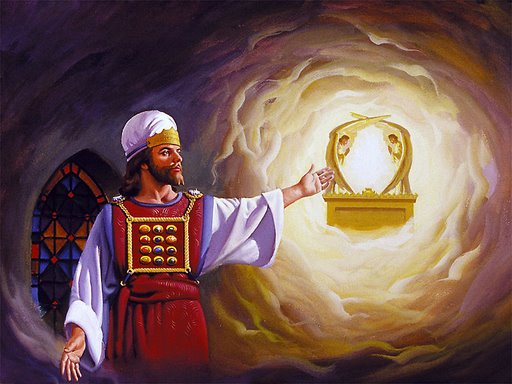
The relationship between the Tabernacle and Jesus is that Jesus claimed to be “the Way, the Truth and the Life” and the doors of the Tabernacle chambers are called, “the way, the truth and the life.” Therefore, if Jesus is the Christ, we will find the same attributes and functions in the life of Jesus as we do in the Tabernacle. We will find that understanding the Tabernacle will also help us to better understand the nature of Jesus such that we can better emulate His life. All of this will help us to move into a closer relationship with God and do the work that He gave us to do on this earth. So, with this brief review in place let up proceed by looking at the physical properties of the Holy Place of the Tabernacle.
Describing the Holy Place
The Holy Place is found inside the sanctuary tent that is found in the center of the Courtyard. The door to the tent is a curtain that is called, “The Truth.” By passing through the Truth one enters a room called, “The Holy Place.”
Prior to entering into the Holy Place it is necessary to first pass through the Courtyard and the Way (reference the diagram). The reason for this is that purity must be achieved prior to entering into ministry in God’s Holy place. Entry into the Holy Place is the exclusive privilege of the priest, as no others are allowed inside. Therefore, God expects our purity to be achieved in the Courtyard. Our sins must be forgiven and our sinful nature addressed.
Like the other compartments of the Tabernacle, the sanctuary was designed by God who passed the specifications directly to His servant Moses:
And let them make Me a sanctuary, that I may dwell among them. According to all that I show you, that is, the pattern of the tabernacle and the pattern of all its furnishings, just so you shall make it. (Exodus 25:8-9)
As a result the sanctuary is both very practical and at the same time, very prophetic of the coming Christ.
The Holy Place uses the east 30 feet of the sanctuary tent and contains three significant objects. It contains the Table of Showbread on the north side;
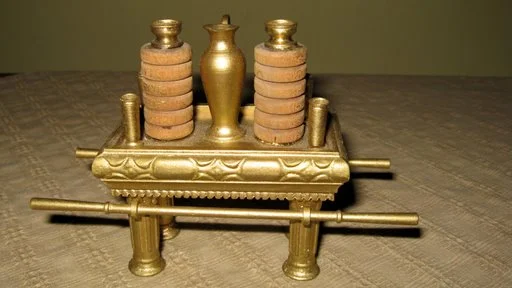
The Table of Showbread
the Golden Lampstand on the south side;
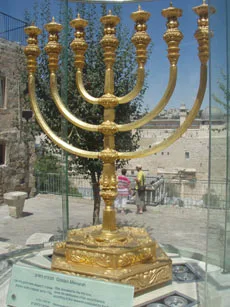
The Golden Lampstand which was present in old temple but damaged, was restored to its original form, kept outside the temple area.
and the Altar of Incense on the west side.

It should also be noted that the Golden Altar of Incense is placed directly in front of the vale (entrance) to the Most Holy Place. From this location a priest ministering at the Golden Altar can view the Ark of the Covenant and the Mercy Seat by simply looking through the semi-transparent vale. We will cover all of this later when we present the section called The Life. For now we will proceed to address the objects found in the Holy Place.
One major difference between the objects found in the Holy Place and Courtyard is that all the objects in the Holy place are made of gold, while all the objects in the Courtyard are made of brass. This is significant because one who stands in the Holy Place is in a more favored relationship with God than one who is in the Courtyard. The gold used in the Holy Place signifies the special presence of God. When we look at the uses of the word “gold” in the bible we find that gold was used to symbolize God’s Word, the wisdom of God, the knowledge that emanates from God, the living favor of God, and truth. All of these attributes are to be associated with the Holy Place and with Christ Jesus as well.
Our next posting will address the details of the Table of Showbread, the Golden Lampstand and the Alter of Burnt Offerings.


dear brethren you doing good work of reaching the unreachable
and telling them the good news and l would like to request for
free Christians books to enrich me with the word of God.rugah
Your book is on the way.
thank you we have to preach because that our calling and servant hood
Hello, I am interested in information on the tabernacle. I found your website by google. I would like to understand all of it. Do you have any materials that I could use to study or learn from. I liked the way you laid everthing out and how it relates to today. You have my email address listed above. I look forward from a response from you.
Blessings
Roslyn
hi i am seeking to learn as much as i can if you offer any free books on the Brazen Altar, the Holy Spirit, and spiritual warfare prayers i would like to request some copies of those books
Thanks for your note. Sorry but I do not have any books like you requested.
God bless,
Papa Joe Gordon
Hi I am writing a manuscript called “The Melchizedek Ministry” I find your comments very affirming of what the Lord has shown me. Could you tell me please where I can purchase the kind of pictures shown on your site. they are very inspiring. God bless you and your ministry. This is a great website Val Pym
PS Against my better judgement I listened to the voice of the devil on one of your videos. i know that in Jesus I am safe from him, but the hairs on my arms and back of my neck stood up and I sensed evil. I am wondering if this is good to show. I am still feeling the effects of it
Hello, and thanks for your nice comments.
The pictures for the most part have been found in Piscca on Google. You can find them there yourself just by searching and then by getting permission from the author for your manuscript.
I am very concerned however about your comment about the voice of the devil on my web site. I currently have no viedos or audios, on my site. So, perhaps you got sidetracked to another site. If this is not the case then I would very much appreciate you sending me information about the page that you found this video, as it did not come from me. Rest assured that I will correct this situation if in fact it exists on my site.
I sould also state that I also have heard the voice of the devil and the circumstatces were totally unexplainable (I did communicate this in a blog posting, but in written form only). If this is the case then perhaps the devil is trying to scare you off your course. Rest assured, you are safe in the arms of Jesus. Do not fear or even consiter being afraid! Know with all certainty that you are protected and seek that protection from the Lord. Stay the course that the Lord has placed you on.
Good luck with your manuscript on, “The Melchizedek Ministry,” and send me a copy if you like, I will review it for you and provide feedback as I see fit.
May the Lord bless you and your family and all that you do. May He put a seven fold hedge of protection arround you and keep you in His arms always.
Papa Joe Gordon
I have been studying John 14:6 and its relation to the Tabernacle. I have seen a few references of The Way, The Truth and The Life being the different entrances to the Tabernacle, but I can find no scriptural reference to such names given to these entrances. Can you provide any that I may use in my study. Thanks in advance.
Sorry, but I do not have any. I first heard about this correlation from a newly ordained Catholic Deacon, so I would assume that it is something that this church is teaching in seminary. If you find any please send me the information you have.
For me, I am satisfied with the new testament scripture that prove that the functionality and purpose of each and every object found in the Tabernacle is fulfilled in an extraordinarily better way in the life of Jesus. This can lead one to the inescapable conclusion that Jesus was the fulfilment of the prophecy that was given to us in the form of the Tabernacle built and documented by Moses. If you can take that leap, then bring in John 14:6, and a light should go on as to what Jesus was communicating. Jesus leads us to the Father through a series of doors. Each door leads to a room that has a purpose and represents our level of intimacy with God. When we follow this pathway we are changed from what we were, into what God wants us to be. When we look at the Tabernacle we can easily see the kinds of gifts we can receive based on the chamber that we are in. It tells us the provisions that we will have when we follow the leadings of the Holy Spirit.
Well, I had better cut this off for now. Good luck in your search and thanks for referencing this site.
May all of God’s blessings be upon you and your family.
Papa Joe Gordon
I concur with Joe. The experiences within the three compartments show why the doors are called The Way, The Truth, and the Life. The Church is about to come through the Veil into the Glory
The Veil is “His flesh” Hebrews 10:20 On that flesh were the sins of all mankind. 1 Peter 2:24 There is a meditation called “Through the Veil” on my blogspot. Ask the Holy Spirit to bring revelation as you read it Val Pym http://valpym.blogspot.com
I am curious about your reference to names of the tabernacle gates. I have heard several people make the assertion that the gates were named the way, the truth and the life, but I’ve not been able to find a good reference to back up this thought. I get and agree with the parallel between the gates and what Jesus said in John 14, but I am looking for something credible that backs up the names of the gates being the way, the truth and the life.
I cannot give you a Scriptural reference, I too am going by what I have heard from others, however I know that the experiences within the three compartments agree with the entrances as being the Way, the Truth and the Life. The Way leads into the Outer Court with the altar of sacrifice [the Cross] and the Laver [sanctification]. The priestly garment [The Holy Spirit] takes us into The Truth where the Holy Spirit leads and guides us into all truth. The end time truth of the finished work of Christ is in the rent veil and what it means for us. Going through the Veil brings us into The Life [the resurrection life of Christ being manifested through His church]. That’s when the Glory of the Holy of Holies will flow out into the world and bring in the final harvest. http://valpym.blogspot.com
Here I am again. My new book “End Time Insights” is out. In it I have a section called ‘The Melchizedek Ministry” which deals with the Tabernacle. I question the statement that the veil is semi-transparent. I believe it was about 4 inches thick. Since it represents all the sin of the world which separates us from God it would have been very thick. Going through the veil into the Glory is where God is leading us. As we have had a personal experience at the Altar on coming into the Outer Court, and a personal experience of the Holy Spirit in receiving the priestly garments to go into the Holy Place; we also need a personal revelation of going through the veil and what it means for us.
Thanks for your comments. I don’t recall why I believe the tabernacle veil was transparent. I took a quick look in scripture but did not find anything. If I do I will let you know.
Thanks again and God bless,
Joe
thanks for your comment! I currently do not have the reference you seek and have given the rational for such a belief in a reply to this very posting, so you can look that up right here. one thing that I did not mention in that reply was that one should look at John 14 in its entire context. The scripture reads:
6 Jesus answered, “I am the way and the truth and the life. No one comes to the Father except through me.
The only way for a Jew to get to the Father was by way of the Tabernacle, so Jesus is claiming to be the living Tabernacle in this scripture. While this may help it is not what you are looking for. Perhaps I will ask some folks who should know. If I find anything I will let you know.
Papa Joe
Hello there! This post could not be written any
better! Looking through this post reminds me of my previous roommate!
He constantly kept preaching about this. I am going to send this article to him.
Pretty sure he’s going to have a good read. Thanks for sharing!
Thanks,
Papajoe
Just a couple of comments. There is one item which most people leave out; that is the Priestly Garment which comes after the Laver. This is the Baptism with the Holy Spirit. “Tarry till you are endued [xclothed] with power from on high;. The Holy Spirit is the Spirit of Truth and comes to lead us into all truth as jesus promised. To understand the deeper things of God we need the revelation of the Spirit on the Word. Also the walk into the Tabernacle is a discovery of the depths of Grace. It is a common error to begin with Grace and get over into works – ‘die to Self’ etc. It’s all about what Jesus achieved not about what we achieve.
Thanks for your comments. I will have to do some research on the garments.
All God’s blessings,
Papa Joe
Hola! I’ve been reading your site for some time now and finally got the bravery to go ahead
and give you a shout out from New Caney Tx!
Just wanted to tell you keep up the great work!
Hi again Joe. Understanding the truth that the Veil represents is of utmost importance. That is where we are at now in our walk into God’s ultimate purpose for us as the Spirit leads us into all truth. While we know that historically the Veil was rent, we have to come to personal revelation of what that means for us, just as the Cross is a fact of history but we need to come into a personal experience of it. The End Time truth which will cause the Church to rise up in victory and glory is the revelation of the finished work of Christ as revealed in the Veil. You have a beautifully presented site. However the overall impression of the walk through the Tabernacle is that we have to ACHIEVE that deeper place. I have found that it is a revelation of what we RECEIVE because of what Jesus did, not because of our works. It is a revelation of the fullness of Grace. “For by one offering He has perfected forever those who are being sanctified.” Hebrews 10; 14 If you like I will send you a copy of an extract from my book “End Time Insights” Sincerely in Jesus Val Pym
Hi Val,
Thanks for your comments! I agree that we can not achieve anything on our own and indeed our righteous revelations of God can only be received from Him. On the other hand, I believe that God is looking for people who are seeking Him and desire to know His truth. I believe that this notion is supported by the following scriptures:
Deuteronomy 4:29
But from there you will seek the Lord your God, and you will find Him if you seek Him with all your heart and with all your soul.
Luke 11:9
“So I say to you, ask, and it will be given to you; seek, and you will find; knock, and it will be opened to you.
So, I believe that the asking, seeking and knocking is something we can achieve if do so with all our heart and soul, like the scripture states. Those that do this will certainly receive all that they search for. In my own case I did not know very much about Jesus until I decided to seek Him with all of my heart. This seeking lead me to the revelation that the Tabernacle was what Jesus was referring to when He said, “I am the Way, the Truth and the Life.
So, was this something I achieved? No. Was it something I received because of actions I took? I think it unlikely that it would have happened otherwise.
I get your point though. I am planning to go back over all of my postings again in an effort to improve them. I will hopefully find these areas where there may be some misunderstanding and make the clearer.
In regard to your book I would appreciate receiving the extract you have identified above. Also is it for sale yet and if so when can I get it?
May God bless all your work,
Joe Gordon
Joe I tried to send the extract but there was a problem. Could you email me direct please Val
That is right Joe! We have to seek Him with all our heart. When we do we discover the depths of Grace. My books are available on Amazon and Barnes and Nobel and other book stores. “The Other Bible Code” published by iUniverse and my latest “End Time Insights – The Cloud Moves On” published by Xlibris I will send an extract re the Tabernacle and entering the Veil which is an end time truth which the Church needs to come into in order to rise to maturity.
wonderful and great job for our God.
If U have a regular publication, I would like to receive it. I have been led by the Holy Spirit to Ur website. The Way-Truth-Life is like (1)——– knowledge -understanding-wisdom, and (2)—–body-soul-spirit, and (3)—faith, hope, love, and other TRI-UNITIES. Thank U!!!
Rodney B. Johnson
Rodneyboy55@gmail.com
Sorry, no regular publication at this time. I would like to enhance my material at some point, God willing, and if so I most likely will be publishing updates on a regular basis.
God bless,
Joe
More grace and God bless u for ur wonderful analogy of the gospel of truth. Please how do I get ur complete book for other mysteries and meaning of term in the Bible especially the new testament relating to old testament with proves. Thks and God bless u
I would like to know more about the topic for years I never understood what Jesus meant by saying am the way the truth and the life. Thank God that I can now understand what he meant by saying this but I feel I need to understand more if you can please send me a copy of your book I believe it will help me a lot. This is the teaching that most Christians of today don’t understand or teach about. I really what the meaning of what Jesus meant by saying am the way the truth and the life I could get anything from anyone by to night I decided to do a search on Google and at least I got some thing which no one could explain to me. Thank you for been used by God to bring light to my understanding. I know there is more I need to learn from the bible.
Thanks for you comments. Actually, so much of my material on the correlation of Jesus to the Tabernacle can be found on my wordpress site. Go to possessthevision.wordpress.com to the home page where you can find a long list of articles that go into the details of how Jesus is the fulfillment of the prophesy of the Tabernacle. I can send you an electronic copy of my book but will need an e-mail address to do so. Thanks again, God bless.
Every Catholic Church has a tabernacle, where Our Eucharistic Lord awaits our adoration. He provided us a means to get to Heaven by becoming our very food (read John 6), which allows us to receive HIM not only in our hearts, but in our bodies as well. This Holy Communion, the Most Blessed Sacrament, reserved in the Holy of Holies after the Sacrifice of the Mass, is only in the Catholic Church, which Jesus came to establish as His Body. He calls us to holiness and provides all the grace we need to become saints through the graces available through the Sacraments of the One, Holy, Catholic, and Apostolic Church. Research Eucharistic Miracles for those who have doubted that what appears to be bread, is in fact the Body, Blood, Soul and Divinity of Jesus, who is, the Way, the Truth, and the Life. All are welcomed to Holy Mass, but only those in the state of grace, who profess belief in all the Church’s teachings, and who have received Baptism and Sacramental Confession are allowed to receive HIM in Holy Communion. Read John 6:66… do not turn away from HIM, too. Oh, Blessed Virgin Mary, help us to receive HIM with a heart like yours… your longing for union with God. Holy angels, help us to receive HIM with purity, as you teach us how to adore Him like you did at Fatima.
Could you
please provide sources for your claims?
Sure, the majority of the work is sourced from the bible.